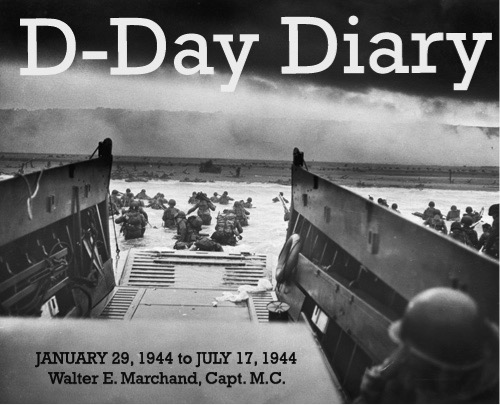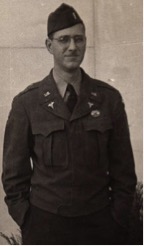
by Walter E. Marchand, MD, Battalion Surgeon, US Army 4th Infantry Division, Later Fort Meade Veterans Hospital
June 6, 1944
D day is here! – D day has begun, how will it end? We are now close to the German held coast of France – all is unbelievably quiet, but it isn’t for long. At about 1 A.M. I hear a low sounding drone – I go on deck and here I see plane upon plane flying over our ship toward the hostile shore, towing gliders – these are the Paratroopers and Airborne Infantry – I wish them God’s speed and wish them well, for as I am watching the first planes are over the Atlantic Wall I see tremendous flares go up and great quantity of anti-aircraft fire and flak. God what great numbers of planes there are, and all ours. To our right – toward the Barfleur Peninsula area our Bombers are wreaking havoc on some coastal installations, we can hear the detonations clearly. In the midst of this, the little Cavalry C.T. is preparing to debark and to take St. Marcouf island – this is at H minus 4 hours. At this time also, the C47s are returning from France – flying home after letting go of their gliders or human cargo.
Had very early breakfast – then lay on my bunk for a while – I couldn’t sleep and I can’t sleep – I keep thinking of my wife and my family – I love you my Corinne. At 0400 the first wave of our Assault Battalion is called to stand-by to load into the boats – there is a great hum of activity throughout the ship. The Captain speaks – our LCM3’s haven’t come yet, but there is still plenty of time. We wait for 20, 40, 55 minutes. Then they come out of the dawn alongside – still enough time to make the H hour landing, for H hour has been upped because of the heavy seas. The LCM3’s are having great difficulty tieing up to the boat – they toss around like corks – but the landing nets are overside and the troops make their way down – but with great difficulty. Often large hausers, 2 inch thick, would snap like a thread and often the man climbing down would be thrown into the small boats. It was especially difficult to get the vehicles overboard into the small boats. “Man overboard” was heard once – a British sailor was knocked overboard but rescued.
First wave – Away, then the second, then the third, then it was my turn to get into my boat with 5 of my men and part of the Battalion Command section – it took long, the boat crashed against the ship time and time again, bending the ramp, and tearing loose, snapping the hausers. Finally we are all in our boat with our equipment, and the men are getting seasick, and they huddle together toward the rear of the boat. I stay near the front of the boat, getting sprayed continuously and I look about me and see hundreds upon hundreds of boats, from the little LCVP’s, LCM’s, LCT’s and LCI’s, to the huge battleships and cruisers, and smoke is billowing from their deck guns, for this is H-40 min. and the Naval barrage starts then, the fire directed against enemy shore installations. Our wave has now formed and we are heading toward shore 7 miles away through rough waters, while on the way in our Dive bombers get to work, pouring tons of bombs against the enemy fortresses.
We are getting close to shore and the boats of our wave go from a line in file to a line abreast formation and speed for shore. I can now hear cannon fire clearly as well as machine gun fire. We all pray that our boat will not strike a mine or an underwater obstacle or get hit by a shell from a coastal battery. All sounds become closer, when about 50 yds. From shore I see 2 splashes on our port bow – enemy fire. The boats streak for shore and hit the beach and we almost make a dry landing – we only have to wade knee deep thru about 20 yds. of water. As we hit, the ramp goes down and we debark – wade in the water, then on hitting dry land start to run. I see dead Americans floating in the water – a ghastly sight. I get my men together and we run up across the beach to a concrete wall, faced with barbed wire and bearing signs. There are many wounded lying about and we start to care for them, and carry some to the Naval Beach Party Aid Station which just landed after us.
I try to orient myself, but we landed at a different place than was originally planned. Enemy fire is increasing, landing just to our left, from our right there is machinegun fire. I have only 1 choice I lead the men thru a break in the barbed wire into the Mine Field and we go in about 50 yds. – enemy fire increases, we dig in hurriedly to rest – we are all exhausted from the fear which we all know as shells come whistling overhead and landing close by. But we must get out of the Mine Field! – I find a path to the right and we start along it, seeing mines all around us – and then the path disappears and we turn back to our former spot – from there we find a small path to the left and we follow it – we see wounded about us and we care for them, carrying some along with us on litters, and the small path leads us to a road and we follow it to the first right turn and we follow it.
Troops and vehicles are now storming ashore in great quantities – some vehicles are hit and burst into flames. We pass burning houses and many dead German and American soldiers. It is now noon – God the 5 hours passed like lightning. At 1300 we come to the “Old French Fort”, now we are close to where originally we were supposed to land. I scout ahead and find my Battalion just 300 yds. up the road, so I and Capt. Scott set up our Aid Station off the side of the road in a large hole and crater made by a 14 inch Naval shell – 12 feet by 5 feet and about 6 feet deep. By this time one of our Jeep ambulances has reached us and we are ready to function as an Aid station. We send out litter bearer groups into the mine fields to pick up casualties. This is ticklish work, but the boys are excellent soldiers and go bravely although they have no paths to follow.
Our ambulance Jeep works up forward and brings back casualties – some are Paratroopers that are pretty well beaten up, having been wounded shortly after landing. We work from this spot for 2 hours and then we move forward to the Command Post which is along the side of a road near Fortress 74 which is still holding out. Shortly after arriving here, machine gun fire becomes active and we have to duck low – pinned down here for 5 hours, could watch the attack on the fortress and the surrender of the Germans. Our boys are doing a splendid job and very few casualties so far. As the sun is setting we note hundreds of C47’s again – more Airborne Infantry landing – They swoop inland and let go of their gliders, to come swooping back. Liaison Sgt., from Co. C shot in the leg while lying on the road beside Capt. Scott.
Toward dark a few serious casualties encountered – difficulty of evacuating great – Plasma given right in open. Difficulty in finding path thru mine field to farm house where we will stay for the night – had to cross tank traps filled with water and lined with mines – ticklish business in the dark.
Finally we got all of Aid station together – we were all exhausted – and were so tired that we just fell down and fell asleep – with artillery, mainly enemy, going overhead, most of it, fortunately for us being directed toward the beach. This is the end of D day – it was hectic from the start – but we had few casualties, and those mainly from mines, which were numerous. Heavy machinegun fire heard all night.


